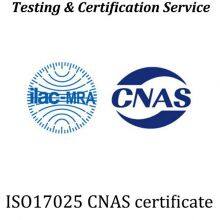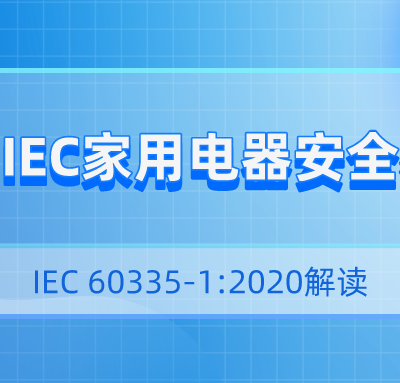Home > Products > Safety Testing > Interpretation of the Withstand Voltage Test in IEC 60335-1:2020
Interpretation of the Withstand Voltage Test in IEC 60335-1:2020
- T/T L/C PayPal D/P Western Union Other
You May Like
-
AC Charging Pile European Certification
-
New National Standard for Chargers (GB42296-2022)
-
French WEEE Registration/French Packaging Law/EPR
-
How Can I Check the Validity Period of EU CE Certification Harmonized Standards?
-
EU REACH Chemical Testing Process for Chargers
-
How do I Apply for UL2849 and GCC Testing for Amazon's US Electric Bicycles?
Product Description
Interpretation of the Withstand Voltage Test in IEC 60335-1:2020
IEC 60335-1:2020 is an international standard for the safety of household and similar electrical appliances. The withstand voltage test (dielectric strength test) is a key test item for ensuring the insulation performance and overall safety of electrical appliances.
The following is a detailed interpretation of the purpose and requirements of the withstand voltage test in IEC 60335-1:2020:
01
Purpose of the Withstand Voltage Test
1. Verify the reliability of the insulation system: Ensure that the insulation material of an appliance effectively prevents electric shock and electrical fires under normal operating conditions and potential fault conditions.
2. Detect potential insulation defects: By applying a voltage higher than the normal operating voltage, defects, aging, moisture, or other problems in the insulation material that may cause insulation failure are detected.
3. Ensure user safety: By verifying that the insulation system of an appliance meets safety standards, users are protected from electric shock, electrocution, and other electrical hazards.
4. Ensure product compliance with international safety standards: Ensure products comply with the requirements of the IEC 60335-1:2020 standard to facilitate product acceptance and sales in the global market.
5. Improve product quality and reliability: Hi-pot testing detects potential problems in the production process, improving overall product quality and long-term reliability.
02
Specific Requirements for Hi-pot Testing
According to the IEC 60335-1:2020 standard, the specific requirements for a hi-pot test include, but are not limited to, the following aspects:
1. Test Voltage
Calculation Method:
· The test voltage is typically calculated based on the product's normal operating voltage. The specific value depends on the type of appliance and the operating environment.
· Generally, the hi-pot test voltage is equal to twice the rated operating voltage. For example, for an appliance with a rated operating voltage of 250V, the hi-pot test voltage is 500V.
AC Voltage:
· Testing is typically performed using alternating current (AC) voltage, which meets the product's actual operating conditions.
· For certain products, pulse voltage or other specified waveforms may be used.
2. Test Duration
Basic Duration:
· The test voltage is typically applied for 1 minute (60 seconds).
Special Circumstances:
· For high-risk or specialized appliances, the test duration may need to be extended, such as 3 minutes, to ensure the reliability of the insulation system under long-term or extreme conditions.
3. Test Frequency and Waveform
Frequency Requirements:
· The applied AC test voltage should be the same as the operating frequency of the appliance, typically 50 Hz or 60 Hz.
Waveform Requirements:
· A sinusoidal wave or a waveform specified in the standard should be used to ensure that the test conditions are consistent with the actual operating environment.
4. Test Conditions
Environmental Conditions:
· The test should be conducted under specified environmental conditions, such as standard temperature (typically 20°C to 25°C) and relative humidity (typically 50% ± 20%).
Product Preconditioning:
· Before conducting the withstand voltage test, the appliance should be in normal operating condition or in accordance with the conditions specified in the standard to ensure the accuracy of the test results.
5. Test Locations
Critical Locations:
· The withstand voltage test should be conducted at all locations on the appliance where insulation weaknesses may exist, including but not limited to:
- Power input terminals
- Control units
- Junction boxes
- Connection points between the outer casing and internal components
Grounding System:
· For appliances requiring grounding, the grounding system should also undergo a withstand voltage test to ensure that the grounding resistance meets standard requirements.
6. Acceptance Criteria
Insulation Performance:
· During the withstand voltage test, the insulation system of the appliance should not experience electric shock, short circuits, discharges, smoke, sparks, or other insulation failures.
Product Condition:
· After the test, the appliance should show no physical damage, functional impairment, or performance degradation and should be able to continue operating normally.
Leakage Current:
· Certain categories of appliances may have specific leakage current requirements after the test, which must comply with the standard.
7. Safety Measures
Test Equipment:
· Standard-compliant insulation test equipment should be used to ensure the accuracy and safety of the test.
Safety of the Test Environment:
· The environment for the withstand voltage test should be free of flammable and explosive substances and equipped with necessary safety equipment.
Operator Safety:
· Testers should wear appropriate personal protective equipment, such as insulating gloves and goggles, to ensure personal safety during operation.
03
Steps for Conducting a Withstand Voltage Test
1. Preparation:
· Confirm that the electrical device under test is in the specified condition.
· Connect the withstand voltage test instrument, ensuring that the connection between the measuring equipment and the device is correct and secure.
2. Applying the Test Voltage:
· Apply the corresponding test voltage according to the calculated method.
· Maintain the applied voltage for a specified duration and observe the performance of the device during the test.
3. Monitoring and Recording:
· Monitor the device during the test for any abnormalities, such as smoke, discharge, or temperature increase.
· Record the test voltage, duration, and any observed phenomena.
4. Termination of the Test and Evaluation:
· After the test, gradually reduce the voltage and disconnect the device.
· Inspect the overall condition of the appliance to ensure it is free of damage and performance degradation.
5. Result Determination:
· Determine whether the appliance has passed the withstand voltage test according to the standard requirements.
· Analyze the causes and implement corrective measures for unqualified products.
04
Summary
The withstand voltage test is an essential safety test item in the IEC 60335-1:2020 standard. Its primary purpose is to verify the reliability and safety of the insulation system of an appliance by applying a voltage higher than the normal operating voltage. By strictly adhering to the standard's requirements regarding test voltage, duration, test conditions, and acceptance criteria, manufacturers can effectively prevent electrical safety incidents and protect the lives and property of users.
Key Points Summary:
Purpose: Verify insulation performance, detect potential defects, ensure user safety, comply with international standards, and improve product quality.
Requirements:
· Calculate and apply the test voltage correctly.
· Ensure that the test duration and frequency meet the standard.
· Conduct the test under specified environmental conditions.
· Cover all possible insulation weaknesses.
Ensure that the product is in good condition after testing.
Implement necessary safety measures to protect testers and equipment.
Manufacturers should strictly adhere to the requirements of IEC 60335-1:2020 when conducting withstand voltage tests to ensure that products meet the necessary safety standards before market release. Regular withstand voltage testing not only helps identify potential problems in the production process but also improves overall product quality and market competitiveness.
Contact Us

- Shenzhen Lcs Compliance Testing Laboratory Ltd.
- Contact nameleo tu Chat Now
- Address1&2/F, Building A, Juji Industrial Park, Yabianxuezhiwei, Shajing Street, Bao'an District, Shenzhen, Guangdong, China, Shenzhen, Guangdong
Product Categories
New Products
-
How do I Apply for EU CE Certification Under the EN62133 Standard for Emergency Power Supplies and Energy Storage Power Supplies?
-
Saudi Arabia's New Energy Efficiency Standard, SASO 2902:2018/AMD2:2023, Will be Mandatory on June 1, 2025.
-
The Australian Government Officially Released the Cybersecurity (Smart Device Security Standards) Rules 2025
-
The REACH Substances of Very High Concern (SVHC) List Has Grown to 250 Items!
-
The IECEE Officially Released the Safety Testing Standard for Button-type Lithium Batteries, IEC 60086-4:2025.
-
On April 9, 2025, Canada's NRCan Published New Energy Efficiency Regulations for General Service Lamps (GSLs)
-
Bluetooth SIG Certification Fees
-
Inverter CE Certification Cost
-
Tablet PC IC Certification Application Process
-
GB/T 24824 Outdoor Luminaire and Lighting Fixture Report
-
Straight Tube Fluorescent Lamp Test Report GB7000
-
Cabinet Light Structure Inspection Report
-
Validity Period of the UN38.3 Report for Lithium Batteries
-
Integrating Sphere GB/T 28135-2023 Test Report
-
LED Desk Lamp A Lighting Certification GB/T 9473-2017
-
AA-Grade Certification for Eye-Protective LED Lamps
-
Switching Power Supply CB Certification Requirements
-
IEC/EN 62471 Blue Light Hazard Test Standard for LED Lamps
Popular Searches
- resistance tester
- test instrument
- lab equipment
- test kit
- test equipment
- electronic instrument
- test machine
- test device
- megger meter
- voltage tester
- high voltage
- megger
- test system
- high voltage generator
- ac dc hipot tester
- ac hipot tester
- high voltage testing
- high voltage test set
- high voltage insulation testing
- withstand voltage test set
- hipot test
- shipping agent
- sea freight
- forwarder
- air freight
- freight forwarder
- ocean shipping
- ocean freight
- silver aluminum profile
- concrete block making machine
Recommended Products
- How to Obtain FCC Certification for a Robot Vacuum
- How to Obtain FCC ID Certification for a WiFi Jammer
- The UL Report Process for Power Banks
- How to Obtain FCC Certification for Floating Lights?
- Application Process for an FCC ID for an Action Camera
- How do I Obtain Battery WEEE Certification, and How Long Does it Take?
- What is the Difference Between KC and KCC Certifications in South Korea?
- How to Apply for CE Certification and Testing for Display Screens
- Do Energy-saving Lamps That Have Already Obtained CE Certification Still Need ERP Energy Efficiency Certification?
- Bluetooth Speaker CE Certification Process
- Bluetooth Headset NBTC Certification Process
- CTA Network Access Permit Application Process and Required Documents
Find Similar Products By Category
- Service > Commercial Service > Other Commercial Service
- Please Enter your Email Address
- Please enter the content for your inquiry.
We will find the most reliable suppliers for you according to your description.
Send Now-
 leo tu
Hi there! Welcome to my shop. Let me know if you have any questions.
leo tu
Hi there! Welcome to my shop. Let me know if you have any questions.
Your message has exceeded the limit.

- Contact supplier for lowest price
- Customized Request
- Request Sample
- Request Free Catalogs
Your message has exceeded the limit.
-
Purchase Quantity
-
*Sourcing Details
Your inquiry content must be between 10 to 5000 characters.
-
*Email
Please enter Your valid email address.
-
Mobile


